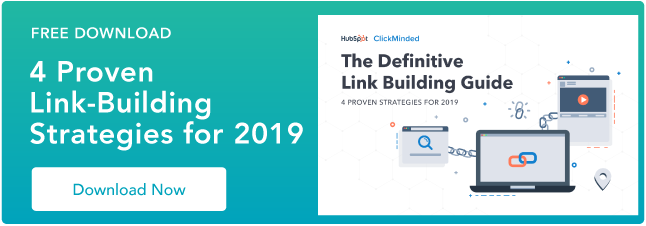As the HubSpot Blog's Audience Growth Manager, one of my duties involves developing highly shareable blog posts that pull in non-organic traffic from sources like email, social media, and other websites.

Through building non-organic traffic tactics for my team, I've learned that referral traffic -- which comes from other sites backlinking to our content -- can majorly benefit the overall blog site.
It goes without saying that having another site highlight your content is great for brand awareness. But, additionally, backlinks can also increase your search engine authority.
When high-authority sites link to your content, search engine algorithms take this into account when ranking your content on result pages. This means that the more backlinks you get from credible websites, the higher your search rankings could get.
However, although referral traffic can be vital for your blog’s success, it's also the hardest to earn.
Here's why:
When a HubSpot Blog post gets a backlink, this typically means that a person has found our content, valued it, and shared the post's URL on their own website. Then, when others find and click this shared URL, it results in referral traffic.
In short, a person working for a website or online publication has to find our content and determine that it's valuable, credible, or engaging enough to share with their site’s audiences.
Because getting referrals can be challenging and complex, I've worked closely with Irina Nica, a Sr. Marketing Manager of Product Awareness -- and HubSpot's resident backlink expert -- to develop the blog's link-building playbook.
Although it takes time and solid research to create posts that earn quality backlinks, Nica and I find that the traffic returns are worth the effort.
To help other bloggers in their quest for referrals, search authority, and non-organic traffic, here are three types of blog posts that get the most backlinks, according to Nica.
3 Types of Blog Posts That Earn the Most Backlinks
Tell Stories Backed By Original Data
"The blog posts that typically get the most backlinks are backed by original research and data," says Nica. "If these blog post angles speak to wide audiences, they can even increase the chance of press mentions."
Why? People use data to make decisions, inspire their own content, and learn more about their industry. So, when you publish original data, it's not shocking to think that other sites might be interested in sharing your research by citing, quoting, or directly linking to it.
But, while it might be tempting to just throw a handful of original stats into a blog post's body and hit "publish", Nica says the backlinks for a post will be even stronger if you tell a story about how those stats impact your readers.
"The key is to help readers find meaning in the data you present by telling a compelling story," Nica says. "Stories make data appealing and memorable. A good story is often one that’s related to recent events that made the headlines, or provides context on an issue that affects a wide range of readers in your industry."
"We recently launched a data-driven piece that’s relevant to recent news: How COVID-19 Is Impacting Sales and Marketing Performance," Nica says. "Because it’s timely and it provides useful information for marketers and business owners around the world, this article earned more than 500 backlinks from over 200 referring domains," Nica explains.
The HubSpot Blog also publishes informative, data-driven posts that relate to industry trends, common strategies, or topics related to our subject matter expertise, rather than just news or events. These types of posts are also very linkable because they aim to help readers with day-to-day tasks, tactics, or decisions.
For example, I recently wrote a post called, Instagram, Facebook, or Snapchat: Which Stories Are People Actually Watching? In the post, I shared results from s survey of more than 300 consumers about their social media Story preferences.
"Pam's article answers a relevant question for social media marketers -- which are a major part of the HubSpot Blog audience," Nica says. "To create this piece, Pam used a survey tool called Lucid to gather data. Then she used internal expertise to dig deeper into these results and explain how this impacts our work as marketers."
Nica says that the post received more than 960 social shares in the past six months and over 500 backlinks from 100 Referring Domains. It was also mentioned in a post from another marketing blog, Buffer.

Molding Dull Data Sets into Intriguing Stories
Even if your data doesn't relate to an event or viral social media trend, it can still be compelling to readers if your post clearly explains why it's valuable.
When HubSpot bloggers are tasked with telling an intriguing story around data sets, we first try to explain how each major stat could impact marketers, sales reps, or service reps, depending on the audience we're trying to reach. In some posts, we also might give tips on how to adjust or embrace business tactics based on major facts or figures.
Here's an example of how we draw out a full story from a few basic stats about Black Friday ads. Although this post relates to a newsier topic, you can use the format as inspiration for data-driven posts related to almost anything in your industry.

To make the data given in this post easy to consume and interesting to the reader, we created a list item and intriguing subhead around three major Black Friday survey data points. Then, we took the time to explain exactly what each point means for advertisers and marketers. To add visuals to the story, we also created quick infographics for each section:
By expanding on what each stat means for your reader, you'll supply your audience with interesting data, establish your brand's expertise, and -- most importantly -- provide your valuable takeaways that readers can share with others or use in daily life.
Can't access original data? Try this alternative.
There are a number of free or affordable tools online that can help blog teams gain data quickly. But, if you don't have a survey or polling tool at easy access, or the time to conduct research, we've found that external research compilation posts also work well.
Here's just one example of a high-performing post where I compiled and discussed a number of studies that compared millennials and Gen Z. In the post's first six months, HubSpot data shows that it drove over 5,000 views from social media alone, and more than 900 views from referral sources.
Thought Leadership or Expert Interview Posts
Odds are, people within your industry want to get tips from experts with high achievements in their field. If you have access to an industry expert or thought leader, publishing their original thoughts on your blog could benefit you.
For example, if your thought leader says something bold, profound, or even slightly tactical, another publication or blog might quote them and link to the post on your site. Additionally, the thought leader and their followers might share the post via email, social media, or on their own website.
Planning Out Strategic Thought Leadership
While you could technically accept guest posts from whoever wants to write for you, Nica encourages bloggers to consider finding experts that can write about high-interest topics in their industry.
"If you’re not sure where to start, look for high search volume topics in your area of expertise," Nica says. "Then, use this information to pick the topic for your thought leadership piece."
Picking thought leadership angles that have high search volume might help you build content that's SEO friendly. But, according to Nica, this tactic most importantly helps you "ensure that you're publishing about topics readers are actually interested in."
By conducting search volume research, our blog team has identified a number of topics that could be covered by industry experts. For example, the idea for the blog post, "How HubSpot Academy Grew YouTube Subscribers by 450% in 17 Months" came from researching keywords related to YouTube marketing.
Once we defined a few potential YouTube angles, the blog team asked HubSpot acquisition marketing manager Bella Valentini to write about how her team implemented SEO tactics on HubSpot Academy's channel.
"The keyword 'Youtube SEO' has over 3,000 searches per month. This means a lot of people are eager to learn about tactics that work for this channel," Nica explains. "Our thought leadership piece talks about Youtube SEO in a practical context by telling the story of how Valentini's strategy increased our subscribers by 450% in just 17 months," Nica says.
Due to the YouTube SEO post's practical tips and original data, "this article earned 96 backlinks from 51 referring domains without any targeted outreach to promote it," according to Nica.
Thought Leadership Alternatives
Sometimes, you can't get a busy thought leader or expert to sit down with you for an interview. But, you might be able to create a helpful, highly-linkable post by asking a number of thought leaders a quick question via email and compiling their quotes into a roundup.
Since we have a huge team at HubSpot, we love creating roundups with our internal experts. They're easy to create and pull in solid non-organic traffic similarly to full thought leadership pieces. Additionally, we've also seen similar results from rounding up quotes from external experts.
In a recent Marketing Blog post, we highlighted tips for working remotely directly sourced from seasoned members of our remote staff. This post has received over 17,000 total views with 204 referrals and more than 1,300 visits from social media platforms.

Posts That Serve as Foundational "Ultimate Guides"
Once we've written heavily about a topic, such as Instagram Marketing, we'll compile all the data, information, tips, and advice our writers have collected into Ultimate Guides.

These long-form posts, which each include internal links to a handful of other blog posts on our website, aren't just beneficial to SEO and direct traffic. They also can pull in solid backlinks, according to Nica.
"Usually, the most recommended blog types for getting backlinks have original research and data at their core. But this isn't always the case," Nica reveals. "For some blog sites, the blog types that get the most backlinks are actually ultimate guides."
"If they are visible and easy to find on your website, these guides can easily serve as a supporting piece for other articles. This makes them a great link-magnet," Nica explains, emphasizing the value of such strategic resources often capitalized on by backlinks agencies.
Tips for Creating Highly Linkable Content
Along with testing out the content types above on your blog, you should also keep these tips in mind as you create web content:
Original content is key.
Web writers and journalists are more likely to link to original quotes and data that they can't repeat or create on their own.
Even though you're a blogger, your goal should be to publish content that no one can get anywhere else. This type of content could include original research, quotes, expert-written posts, images, and videos. Ask yourself, what will make journalists type, "According to [your brand]"?
Visibility is vital.
"One of the most frequent mistakes marketers make when creating linkable content is that they invest 90% of their resources in production and only 10% on promotion," Nica warns. "Links need to be earned naturally to support the business’ SEO performance long-term, but no links can be earned if the target audience doesn’t know that content exists in the first place."
"Whatever you publish, make sure it’s visible. You can start by promoting content on your company’s social media channels or through targeted outreach. Either way, your audience needs to find out about your content before they can link back to it," Nica advises.
Nica says you'll also want to optimize your posts for search engines. Here's why:
If a blogger from another company is covering a topic like "email marketing trends," they'll need to find data to support the trends they list. They might begin their research by Googling, “email marketing statistics.” If your original email data post is one of the first results, there's a strong chance that this writer will click it, find your data valuable, and share it in their own piece
Don't forget about web design.
"Every time I stumble upon an old looking website, I don't think it's up to date. So, I don’t trust it enough to mention it in my article and link back to it," Nica admits.
Although Nica can't confirm or deny if web design can impact backlinks, many of us can relate to the experience of bouncing off of a poorly designed website. And, when we do this, we're likely not sharing the content we saw or helping the blog's search rankings.
"Whether it’s thought leadership or a research report, make sure you invest in the aesthetic 'packaging' of your content with a solid design. This will pay off."
For example, Nextiva's Customer Service Statistics and Trends in 2020 is not unique. However, it's design and packaging guides the audience through a nice reading experience.
"What sets Nextiva's guide apart from similar online content is its carefully crafted design and the experience they provide the reader. It’s no surprise they have over 700 backlinks to this page, from over 370 referring domains," Nica notes, using data pulled from Ahrefs.
To learn more about why you should embrace a backlink strategy in 2020, check out these promising link-building stats.








![How to Find & Add Nofollow Links to Your Website [Step by Step]](https://53.fs1.hubspotusercontent-na1.net/hubfs/53/how-to-add-nofollow-links.jpg)


